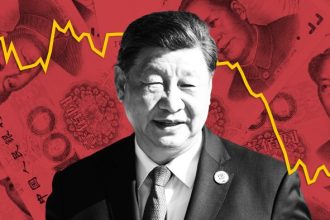January’s hotter-than-expected inflation report threw the financial market into a tailspin on Tuesday and upended investors’ expectations about how soon and by how much the Federal Reserve might start cutting interest rates.
Stocks tumbled, with the Dow Jones Industrial Average
DJIA
finishing down by 524.63 points. Treasurys sold off aggressively, pushing yields to their highest levels since December. And the ICE U.S. Dollar Index
DXY
jumped 0.7% to a three-month high.
January’s consumer-price-index report, out Tuesday morning, suggests that the road toward the Federal Reserve’s 2% goal for U.S. inflation is going to be more than simply bumpy. It’s possible that investors and policymakers may have completely misjudged how powerful inflation will be, although it will take at least one more month of data to prove the point. Until then, the higher-for-longer theme in interest rates reverberated on Tuesday, with traders pushing the likely timing of the first Fed rate cut back to June and with the 1-year Treasury yield
BX:TMUBMUSD01Y
touching 5.01%.
“If this continues, we are in a no-landing and no-rate-cut scenario, where economic growth stays above trend, unemployment stays low and you keep getting inflation surprises,” said Ben Emons, a senior portfolio manager and head of fixed income at NewEdge Wealth in New York. “You can’t expect inflation to decelerate with the economy growing faster. You need growth to be below trend.”
Even before January’s CPI report, parts of Wall Street were contemplating scenarios in which the Fed might not cut rates at all this year and investors might need to factor in the risk of rate hikes. One big reason is that the economy may be in an environment in which the so-called neutral rate of interest that neither stimulates nor restricts growth may have moved up.
There have been growing concerns that inflation could reignite, as expressed by economist Tiffany Wilding of California-based bond fund Pimco; James Solloway, chief market strategist and senior portfolio manager at Pennsylvania-based SEI Investments
SEIC,
; and Brent Schutte, chief investment officer at Milwaukee-based Northwestern Mutual Wealth Management Co.
Even after accounting for the lagging effects of monetary policy, which can take six months to a year to filter through the economy, the U.S. economy is refusing to buckle under the Fed’s series of rate increases, which have pushed up borrowing costs by more than five full percentage points since March 2022.
In January, the U.S. created 353,000 new jobs as unemployment stayed at 3.7%. Business-activity growth also accelerated last month, based on S&P Global’s U.S. services purchasing managers index. And now the annual rate of inflation, as measured by the consumer-price index for January, is stuck above 3% for an eighth straight month, defying economists’ expectations for it to fall below that mark.
“Today’s report was a great reminder to the market of how we still have more work to do, and the pathway is not as orderly as the market was expecting,” said economist Lauren Henderson of Stifel, Nicolaus & Co. in Chicago. “One inflation report isn’t going to sway the Fed, which is going to look at the totality of the data. That being said, today’s report wasn’t a great report. This idea of an orderly descent that the market has been expecting seems a little like a fairy-tale scenario.”
Stifel’s worst-case outlook is “a stagflation scenario whereby growth slows or moderates and inflation remains elevated, which could be potentially worse than a recession,” she said via phone on Tuesday.
“If we do continue to see another month of higher-than-expected inflation, that could certainly change the conversation to additional rate hikes. But at this point, the higher-for-longer scenario is more likely, whereby the Fed has to hold rates at a higher level than the market is expecting.”
For now, fed-funds-futures traders see a 75.8% likelihood of at least a quarter-point rate cut by June, pushing out prior expectations for a move in May, according to the CME FedWatch Tool. They’ve also pared back the number of rate cuts they foresee by December, with the greatest likelihood coalescing around at least three cuts, rather than four or five.
A team at Washington-based Monetary Policy Analytics that includes former Fed governor Larry Meyer called the January CPI report “ugly” and “very strong” in the “exact wrong way.” Arnim Holzer, global macro strategist at Easterly EAB Risk Solutions, said the fact that core inflation remains elevated is “disconcerting.”
“Inflation is going to prove more resilient, but I’m reluctant to read too much into this, partly because I don’t really think it changes the Fed’s view,” said Marc Chandler, chief market strategist at Bannockburn Global Forex in New York. Considering that the annual headline CPI rate came in lower relative to where it was in December and the year-over-year core reading was unchanged at 3.9%, he said, “today’s data will be seen as a continuation of the trend of moderating inflation.”
Read the full article here





